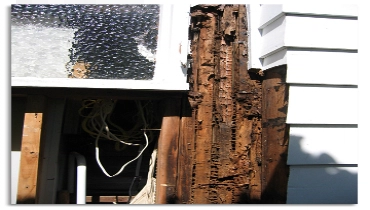How to Repair and Replace Damaged Wood from Dry Rot

Dry rot is a homeowner’s nightmare, with dry rot wood repair a very close second. Not only is it unattractive, but it can also threaten the structural stability of your home. A structurally unsound home is also unsafe!
If you suspect you have dry rot in any area of your home, contact an experienced handyman in your area for help. A pro will be able to assess the damage and offer a solution to fix the problem.
Before we get too deep into how to fix your dry rot problem, let's find out how it happens in the first place.
What Causes Dry Rot in Wood?
Dry rot results from a particular species of fungus that thrives off of moisture in wood. If you see a white or gray growth on your wood, it’s likely this fungus’ spores have landed on the wood and started consuming it. In advanced stages of dry rot, you may even see mushroom-like growths on the wood. If it gets to this point, replacing the wood is usually the only option.
Other signs of dry rot include blistered, cracked, or peeling paint. You can also tell if you have dry rot, if the wood is darker in certain areas, or if you notice green algae growing where it shouldn’t be.
Window sills and door frames are the most commonly affected areas due to their contact with the outside elements and exposure to moisture, but dry rot can also move onto non-wood surfaces such as plaster and mortar.
Should I Repair or Replace Dry Rot?
Depending on how much dry rot has infected your wood, you may be able to repair it. However, if it has gotten into the areas of structural support, such as beams, joints, or flooring, it is highly recommended that you replace the damaged wood completely.
Whether you decide to repair or replace the damaged wood, the conditions that caused the dry rot to thrive must be addressed first. If you don’t, there’s a good chance that it will return and damage the wood again.
Before starting any replacement or repair work, the cause of the moisture will need to be identified and resolved. Check for roof leaks, damaged gutters, plumbing issues, poor ventilation, or other areas that allow trapped moisture to penetrate the wood.
While this process can get time-consuming and tedious, it’s important to identify the source so you’re not dealing with the same problem over and over again. If you start to feel overwhelmed, stop and contact an experienced handyman. A skilled and experienced professional will know exactly where to look, how to remedy the situation, and ensure it doesn’t happen again.
How to Repair Wood Damaged by Dry Rot
If you feel the area is repairable and you're confident enough in your dry rot repair skills, follow these steps:
-
Start by removing as much infected wood as possible with a wood chisel and wire brush.
-
If you cannot reach it all, inject an epoxy consolidant into the wood through drilled holes. It will reinforce the affected wood fibers and bond with unaffected surrounding areas. You can find this at most home improvement stores.
-
A wood-patching product can then complete the repair once the epoxy consolidant has cured. You apply the putty-like material to the rotted wood. Once cured, you can use a chisel and sandpaper to shape it to the desired form.
When you choose to repair and not replace, you risk not getting all of the affected wood and allowing the fungus to spread deeper into the structure of your home. Only attempt repair if you have DIY experience repairing wood damage – otherwise, enlist the help of your professional handyman.
How to Replace Wood Damaged by Dry Rot
Just like repairing wood dry rot, replacement is a tedious job, but it’s a process that will pay off in the long run.. Only attempt to replace the dry rotted wood if you have experience in major home renovation projects. Replacing the dry rotted wood includes the following:
- Removing all rotted wood plus an additional three feet of surrounding wood to ensure no fungus remains.
- Removing all plaster, skirtings, paneling, linings, and ceilings to ensure no fungus remains.
- Cleaning all surfaces, including steel and pipes, within five feet of the rotted wood or other material.
- Applying fungicide to all surfaces within five feet of the rotted area.
- Replacing with pressure-treated wood.
- Replastering or painting with a zinc oxychloride product to prevent the dry rot from returning.
Throughout this project, you must remove all rotted materials from your home and dispose of them appropriately. Again, as with repair, the goal is getting all of the affected wood so the fungus does not spread deeper into the structure of your home.
Dry Rot vs. Wet Rot
Many homeowners also think dry rot is wet rot, which is caused by a completely different fungus. In the case of wet rot, it also requires repair or replacement of the affected wood. If you need clarification, contact a professional like Mr. Handyman® to ensure your home is cared for correctly.
Professional Home Repair
Whether you need help replacing wood affected by dry rot or have a different home repair need, Mr. Handyman is here to help! One call to our home repair experts will get your home in tip-top shape.
Stay on top of your repairs, improvements, and maintenance needs with our help! All of our work is backed by the Neighborly Done Right Promise™, which guarantees your satisfaction. Call us or find the local Mr. Handyman team near you!
 Click to call
Click to call


